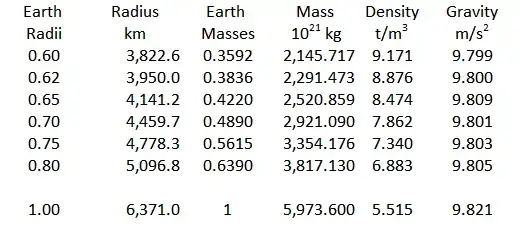Without resorting to solid osmium inner cores that we couldn't give an origin story for, what's a cosmologically plausible lower bound of a planet's radius that also maintains 1G gravity and the sort of mantle conditions you need for plate tectonics?
Asked
Active
Viewed 254 times
1 Answers
5
Using the same methodology I used in my answer to How Big Can a Habitable Planet Get Before Its Gravity is More Than 0.8 m/s² above Earth's 9.81 m/s²? I've made the following table. The last line is data for Earth.
A planet that has a radius that is 0.62 the Earth radius and 0.3836 the mass of the Earth will have a surface gravity very close to $g$ and an average density of 8.876 t/m3 (g/cm3). This density is very close to the density of Kepler-10b.
All that is needed for plate tectonics are significant oceans above the subducting plates so water can lubricate the plates during subduction.
-
2dont forget that plates also require an active core thats hot enough and moving around often enough to keep the plates from settling too soon – zackit Apr 13 '21 at 16:23
-
What I was thinking would be an issue for plate tectonics is the requirements for mantle fluidity. Otherwise you can just stipulate a relatively pure iron planet (or hell, even a chthonian. It takes quite a while for those to bounce back to hydrostatic equilibrium). Would that not be an issue? – MaximalDestrier Apr 14 '21 at 17:24
-
1@MaximalDestrier: You are correct. – Apr 15 '21 at 05:28
